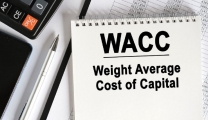1. What is WACC?
WACC (Weighted average cost of capital) is the weighted average cost of capital. This index is used to calculate the average cost of capital based on the proportion of existing types of capital in the enterprise.
WACC is usually calculated as a percentage. This index represents the minimum profit that a business must earn during its operations to satisfy its creditors, owners or investors. This index cannot be determined by factors within the business but from the external market. This is an important index that investors are interested in when they want to invest in a business.
In general, the higher the weighted average cost of capital, the riskier the investment in the company. For example, if a company has a WACC of 5%, it means that for every dollar of financing (through debt or equity), the company needs to pay $0.05.
 What is WACC?
What is WACC?3. How to calculate WACC correctly
Businesses often have to use different forms of capital mobilization to meet the financial requirements of a particular project. However, each type of capital source has a different cost level. That is the reason why any business needs to calculate the weighted average cost.
Weighted average cost (WACC) is calculated using the formula:
In there:
- K E is the cost of equity capital..
- K D is the cost of debt.
- E: Market value of equity.
- D: Market value of debt.
- V (E + D): is the total long-term capital in the enterprise..
Please refer to the following example to better understand how to calculate WACC:
A joint stock company has a total capital of $6000, including two sources of capital: borrowed capital and equity capital. Of which, the value of borrowed capital is $2400, accounting for 40%. Equity capital is worth $3600, accounting for 60%. The capital structure is considered optimal.
Knowing that the pre-tax cost of debt capital of the enterprise is 10%/year. The cost of equity capital is 14.3%/year. The corporate income tax rate is 25%/year.
Then, we can calculate the weighted average cost of capital (WACC) = 60%*14.3% + 40% * 10%*(1-25%) = 11.58%.
>>>> See More: 10+ Latest financial report templates according to Circular 133, 200 Excel
3. Meaning of WACC index
Most businesses today operate with many different sources of capital, of which borrowed capital accounts for a large proportion. Therefore, the WACC index is of great interest to assess the potential of a business. Under normal conditions, a business with a low WACC is considered to attract investors with lower costs.
In the field of corporate finance, the WACC index plays an important role. The reason is that WACC measures the cost of capital of a company, which is the most important factor of any organization. This index is equally important to evaluate the potential of an upcoming investment project or merger and acquisition of another business.
4. What is a good WACC?
First, the WACC index in different industries is different. For example, small companies and startups often have higher WACC because they are more risky. This is the opposite in large, stable companies. In general, a lower WACC shows that the business has a high level of safety and less risk.
Whether a WACC is good or bad depends on the industry in which the business operates. For example, heavy industries, such as oil, which require huge amounts of capital, will need to borrow a lot, leading to an increase in the WACC. Small companies also tend to do this because they need a lot of debt to grow their businesses.
The formula for calculating the weighted average cost of capital is based on the balance between the cost of debt and the cost of equity. Therefore, there is no single WACC that is considered the best. A low WACC can be considered a stable company with low cost of capital. However, this is not necessarily good in all cases because it can show that the company is too dependent on external debt capital and is not balanced with equity capital.












Replies to This Discussion